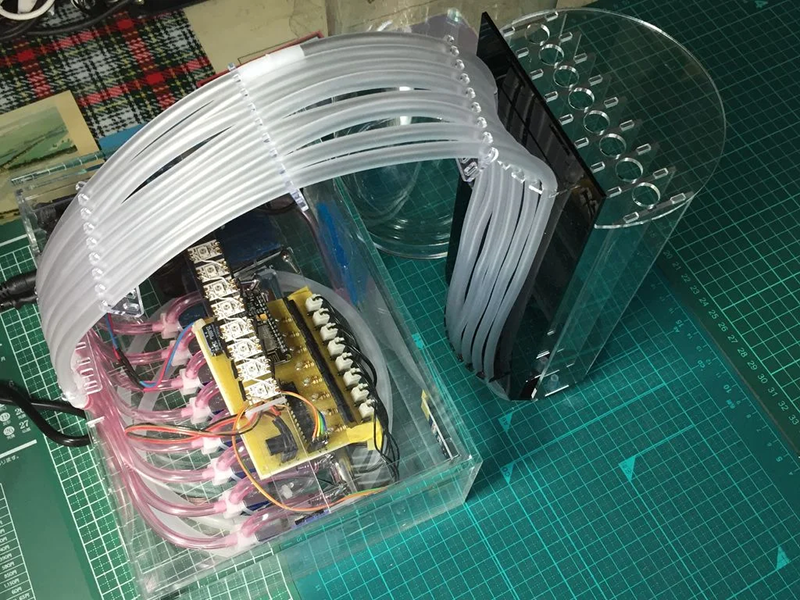When [DonHo] sang about tiny bubbles, he probably wasn’t thinking of them embedded in glycerine. But that’s where the bubbles in [ShinodaY]’s clock reside. The viscous fluid holds the bubbles better allowing the time to be read more easily. You can watch the relaxing display in the video below.
The theory of operation is simple and reminds us somehow of a reverse Tetris game. Solenoid valves at the base release air bubbles to form a row of the display. The bubbles rising makes room for the next row. The display has as many columns as there are air outlets at the bottom. Spacing the bubble pixels is as simple as adjusting the timing between air bubbles.
An ESP8266 controls the whole thing thanks to an I/O expander. Some Neopixel LEDs make the whole thing look cooler.
This is the second version of the clock. The first version (see the second video, below) used water, and we think you’ll agree the glycerine makes all the difference.
The project is as much aquarium work as electronics. We also had to wonder what else you could display like this? Maybe some crude graphics or tweets? Perhaps using it as a form of interesting game would be cool, especially if it were significantly scaled upwards.
For example, we remember one very large bubble display (note: the outbound link has changed). You can even make a 3D display — sort of.
















“Tiny bubbles, in the clock, if you don’t like them, you can suck a …”
This would be good for reading tweets, maybe have people tweet the bubble display, make a video of the display and then post the video to the bubble display’s twitter account.
Cool, firing off lots of random thoughts here.. Wonder if you could do it in a non-newtonian fluid and kind of freeze display by applying vibration for a second or two. Or do it somehow electrostatically. Or some compressible/expandable fluid you can screw with buoyancy of maybe CO2 bubbles by screwing with pressure. Also, scanning array of ultrasonic transducers at bottom, top or sides that focus at points to create bubbles in a fluid. Or maybe just matrix style x and y transducers. Then also there’s magnetorheological fluids you could maybe freeze bubbles in temporarily, or accelerate them into position then go slo-mo or freeze..
If instead of two flat plates, the mechanism had two concentric cylinders, the cylinders could rotate at varying rates, first not rotating at all, so that new patterns can be put into the fluid. Then once the bubbles have been “written”, the cylinders can rotate at a speed that just keeps up with the movement of the bubbles through the glycerine, stopping the apparent motion.
Or are we just trying to re-invent e-paper?
Once it’s a cylinder, it seems as though it’d have to be a closed system which then introduces the problem of introducing air into a container of fixed volume. I guess you could have a bleed off valve, and a portion of the tube with a reservoir of extra air out of sight.
I was already mulling over this problem because I was thinking about the tubes being sideways and circulating the glycerine so the bubbles ran from left or right (or visa versa for Japanese/Hebrew/etc.). At least with text, it would be easier to read.
The air injection nozzles could be fed by thin tubes at the bottom between the cylinders, and air could be vented out the top, to the sides, of course. If I only had unlimited time…
So cool! If I were to attempt something like that I’d try to make more and smaller bubble emitters so you could pump out 4 digits at once, so you’d read the full time as it was floating up. Really cool idea. Dang, the last thing I needed was something else to think about making!
You get my full allotment of hacker points for the day.
Air bubbles rising thru 4 and even 8 foot florescent tubes cleaned out was used in more than one sci fi movie as props. A whole wall of them, could make a big screen.
I wonder if one can build some sort of almost silent valve and almost silent source of compressed air (slow syringe?) so, with a little insulation, it can be totally silent (of course it can be built, after all this is hack a day).
And draw the numbers as a dot-matrix instead of binary. And add a ESP8266 so it is set from nist.